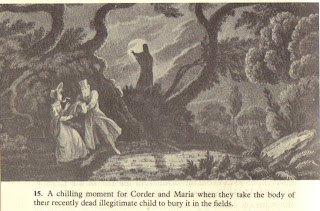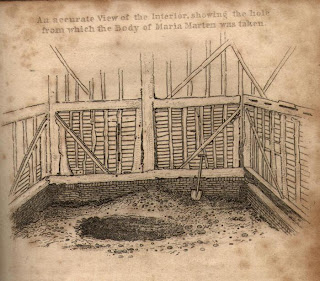The title below links directly to the online copy.
Tuesday 20 November 2007
William Maginn's book available online
I searched around for the Maginn book today with the aim of trying to obtain it in some shape or form only to find that it is available online in full at Google Books.
The title below links directly to the online copy.
The title below links directly to the online copy.
Sunday 18 November 2007
William Maginn
Peter Haining in Buried Passions suggests that the book that transformed the original story into a more theatrical 'villain verses innocent maiden' that pervades the public perception of the murder was not the James Curtis book (written at the time of the trial and famously bound in Corder's skin). It was rather a book by William Maginn called The Red Barn. This version of the story apparently is quite similar in content to the plays that were performed about the murder. The plates below were originally from The Red Barn (by way of Peter Haining's Buried Passions).










Saturday 3 November 2007
Differing Views on the Murder
Maria Martin was murdered then buried in the barn.
The depictions below give an impression of where the body was buried.
 (from the St. Edmundsbury Borough Council website)
(from the St. Edmundsbury Borough Council website)
 (from Buried Passions: Maria Martin and the Murder in the Red Barn)
(from Buried Passions: Maria Martin and the Murder in the Red Barn)
The depictions below give an impression of where the body was buried.
 (from the St. Edmundsbury Borough Council website)
(from the St. Edmundsbury Borough Council website) (from Buried Passions: Maria Martin and the Murder in the Red Barn)
(from Buried Passions: Maria Martin and the Murder in the Red Barn)Supposedly Maria Martin's father, Thomas Martin was motivated to search for Maria's body by his wife, Ann Martin (Maria's step-mother). It is commonly thought that she had a succession of dreams that convinced her of Maria's fate and final resting place. It has been argued that she had prior knowledge of the murder and, in order to take revenge on William Corder, she fabricated the dreams as means to tell people without incriminating herself. In this version of events her relationship to Corder was obviously different, it suggests that she was in cahoots with Corder and was fully aware of Maria Martin's death. This leads me to wonder then why Corder didn't accuse Ann Martin of being involved. The other option was that she was so convinced of Corder's guilt, she used the dreams as a ruse to convince everyone that what she believed was true.
Donald McCormick (writer of The Red Barn Mystery: Some New Evidence on an Old Murder) posits that the murder was a tangled web involving a host of characters, but chiefly had Samuel 'Beauty' Smith, a criminal who eventually was transported to Tasmania, as the real killer (Corder supposedly shooting her, but not fatally). But both these explanations like any other views about the murder that include a third party, make you wonder why (if any of them were true) Corder remained tight-lipped.
Donald McCormick (writer of The Red Barn Mystery: Some New Evidence on an Old Murder) posits that the murder was a tangled web involving a host of characters, but chiefly had Samuel 'Beauty' Smith, a criminal who eventually was transported to Tasmania, as the real killer (Corder supposedly shooting her, but not fatally). But both these explanations like any other views about the murder that include a third party, make you wonder why (if any of them were true) Corder remained tight-lipped.
Subscribe to:
Posts (Atom)
